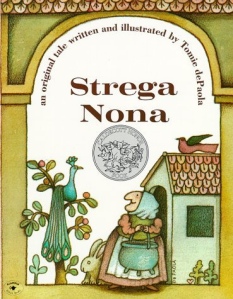Strega Nona is a classic tale about a “Grandma Witch” that needs assistance with her house and garden. Strega Nona hires Big Anthony and gives him specific instructions to not touch her magic pot. During Strega Nona’s excursion to see her friend Strega Amelia, Big Anthony decides to make the most of his boss’ departure. Sure enough, Big Anthony goes and repeats the magic words that make the pot bring forth glorious noodles. To his dismay, Big Anthony cannot make the pot stop producing noodles and the noodles fill up the house and overflow out of the house. The noodles continue growing and begin to fill up the town. Upon Strega Nona’s return, she magically ends the never ending pasta. Big Anthony learns a lesson when Strega Nona graciously offers him a fork to begin cleaning up his noodle mess. The illustrations in this story are captivating and hold the reader’s attention. This story is especially enjoyed by a younger audience (age 4-8), perhaps those students needing more visual reinforcement. Tomie de Paola’s story and illustrations are classic and not to be missed.
Insight:
Strega Nona is the grandma we all secretly long for. She teaches her moral lessons silently, letting us learn by making mistakes through experience and trials. My favorite aspect of this story are the illustrations. The illustrations call to mind Medieval paintings-with their flat 2dimensional appearance. This story is a classic, delighting both young and old.
Suggested Library Activity:
Begin a multiplication lesson reading this story. Have students put one elbow pasta in to the pot. Retrieve two elbow pasta magically out of the pot. Relate this to multiplication. Write the multiplication sentence on chart paper. Do this again and again doubling the elbow pasta each time. Record on the chart to share whole group. Have students illustrate their own pots and record what comes out of their pots.
Bibliographic Citation:
DePaola, T. (1975). Strega nona: An old tale. Englewood Cliffs, N.J: Prentice-Hall.
Additional Book Review:
“From my old review: “Strega Nona lives by her lonesome in a small cottage in Calabria, Italy. A witch by trade, she cures the townspeople of their ailments, warts, and headaches. When Big Anthony is hired on as Strega Nona’s servant she gives him very strict instructions on what he is required to do, and what is forbidden. Quoth Strega Nona, ‘The one thing you must never do is touch the pasta pot’. You see where this is going. After watching the witch conjure delicious cooked pasta fully formed from the pot, Anthony is eager to show this miracle himself to the people of the town. When Strega Nona leaves on a trip, Anthony speaks her spell and feeds everyone in the vicinity delicious, piping hot pasta. Unfortunately, Anthony didn’t quite catch the trick to making the pasta stop flowing. As the villagers attempt to prevent the growing threat from destroying their town, Strega Nona arrives just in time to put everything right again. Anthony receives a just comeuppance and all is well in the world.”
Apropos of nothing, I always thought that Big Anthony was kinda cute. This is why I’ve been careful to avoid marrying any picture book characters. I have terrible taste in their men.
Top 100 Picture Books Poll Results. (2009, April 14th). Strega Nona: an old tale [Review of the book Strega Nona]. School Library Journal Online.



